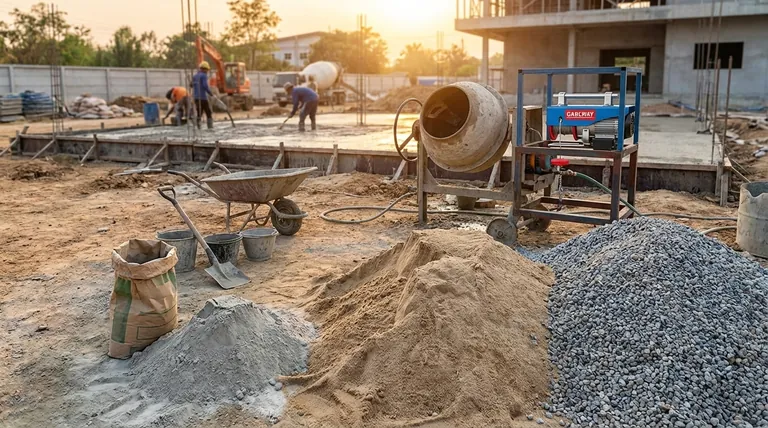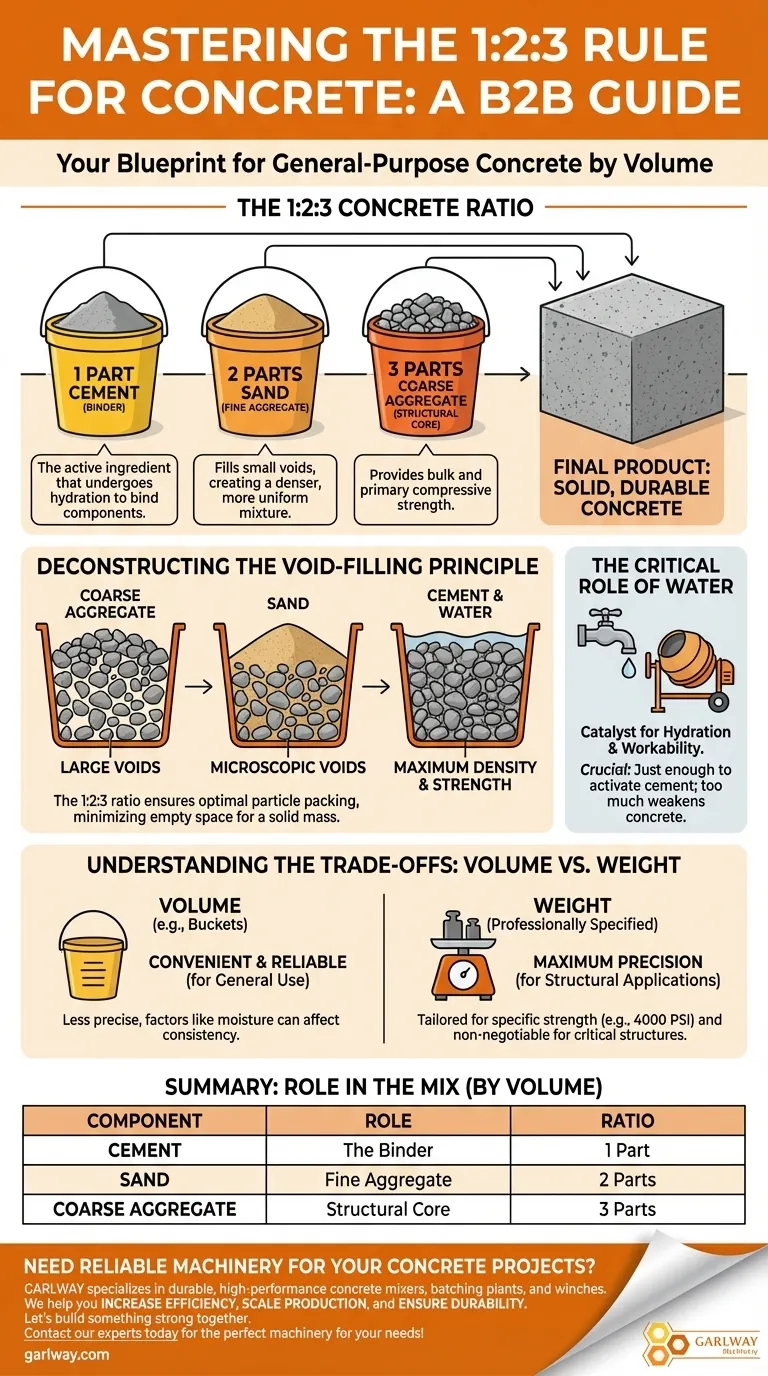At its core, the 1:2:3 rule for concrete is a straightforward recipe for mixing a general-purpose concrete by volume. It dictates a ratio of one part cement, two parts sand (fine aggregate), and three parts coarse aggregate (like gravel or crushed stone). This recipe provides a reliable starting point for creating strong, durable concrete for a wide variety of common projects.
This isn't just a random recipe; the 1:2:3 ratio is a time-tested formula designed for optimal particle packing. It ensures the cement paste completely coats the sand, and that resulting mortar then fills all the voids between the larger stones, creating a dense and solid final product.

Deconstructing the 1:2:3 Ratio
To understand why this rule works, you must understand the specific role each component plays in the final mixture. Each ingredient is a critical piece of the structural puzzle.
Part 1: Cement - The Binder
The cement is the active ingredient. When mixed with water, it undergoes a chemical reaction called hydration, forming a paste that binds all the other components together as it cures and hardens.
Part 2: Sand - The Fine Aggregate
Sand acts as a fine filler. Its primary job is to fill the small voids that would otherwise exist between the pieces of coarse aggregate. This creates a denser, more uniform mixture.
Part 3: Coarse Aggregate - The Structural Core
The gravel or crushed stone is the backbone of the concrete. It provides the bulk of the material's compressive strength and dimensional stability, acting as the primary load-bearing element.
The Principle Behind the Ratio: Maximizing Strength
The genius of the 1:2:3 ratio lies in its efficiency. It's a system for creating a solid mass with minimal empty space, which is the key to strong concrete.
How Each Component Fills the Voids
Imagine a bucket filled with large stones (the coarse aggregate). You'll notice significant empty space, or voids, between them. The two parts of sand are just enough to fill these voids.
Now, even within that mix of stone and sand, microscopic voids still exist. The one part of cement, when activated by water, creates the paste needed to fill these final tiny gaps, coating every grain of sand and stone to lock the entire matrix together.
The Critical Role of Water
While not explicitly part of the "1:2:3" name, water is the catalyst that makes everything work. You need to add just enough water to activate the cement and make the mix workable. Too little water prevents proper hydration, while too much weakens the final concrete by creating larger voids as the excess water evaporates.
Understanding the Trade-offs
The 1:2:3 rule is a powerful guideline, but it is not a substitute for an engineered mix design. Its primary limitation is its reliance on volume, which can be less precise than measuring by weight.
Volume vs. Weight
Measuring by volume (e.g., with buckets or shovels) is convenient for smaller projects but can be inconsistent. Factors like moisture content can cause sand to "bulk," changing its volume and throwing off the ratio's precision.
When the 1:2:3 Rule Isn't Enough
For high-stress structural applications like foundations, support columns, or suspended slabs, a professionally specified mix design is non-negotiable. These designs measure ingredients by weight for maximum precision and are tailored to specific compressive strength requirements (e.g., 3000 PSI or 4000 PSI).
Making the Right Choice for Your Project
Use the 1:2:3 rule as a reliable tool for the right applications. Your project's requirements should always dictate your approach to mixing concrete.
- If your primary focus is general-purpose projects (like post footings, small slabs, or walkways): The 1:2:3 volumetric ratio is an excellent and reliable method for producing strong, durable concrete.
- If your primary focus is high-strength structural work (like a foundation or load-bearing beam): You must use a professionally specified mix design where all components, including water, are measured by weight.
- If your primary focus is achieving a specific finish or workability: Start with the 1:2:3 rule, but be prepared to make minimal adjustments to the water content, understanding that this will impact final strength.
By understanding the principles behind this fundamental ratio, you can mix concrete with confidence and achieve predictable, high-quality results.
Summary Table:
| Component | Role in the Mix | Ratio (by Volume) |
|---|---|---|
| Cement | The binder that hardens and holds everything together | 1 Part |
| Sand | The fine aggregate that fills voids between stones | 2 Parts |
| Coarse Aggregate | The structural core (gravel) that provides strength | 3 Parts |
Need Reliable Machinery for Your Concrete Projects?
Mixing the right concrete is just the first step. You need durable, high-performance equipment to get the job done efficiently. GARLWAY specializes in construction machinery, offering concrete mixers, batching plants, and winches trusted by construction companies and contractors globally.
We help you:
- Increase Efficiency: Our concrete mixers ensure a consistent, homogenous mix every time.
- Scale Production: From portable mixers to full batching plants, we have solutions for projects of any size.
- Ensure Durability: Built with robust materials for long-lasting performance on demanding job sites.
Let's build something strong together. Contact our experts today to find the perfect machinery for your needs!
Visual Guide

Related Products
- Electric and Hydraulic Winch for Heavy Duty Applications
- Belle Cement Mixer JS2000 Volumetric Concrete Mixer for Harbor Freight
- JZC500 Large Cement Mixer Machine Price for Concrete Mix
- Portable Electric Concrete Mixer Machine for Cement Mixing
- JZC400 Mobile Small Concrete Mixer Cement Mixer Machine
People Also Ask
- How long can you run an electric winch? Master Safe, Efficient Vehicle Recovery
- Can an electric winch be used as a hoist? Understand the Critical Safety Differences
- How to maintain an electric winch? Ensure Peak Performance & Reliability for Your Projects
- How do I choose an electric winch? A guide to safe and effective pulling power.
- What is the difference between electric winch and electric hoist? Essential Safety & Application Guide



















